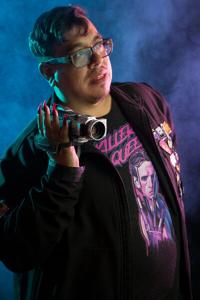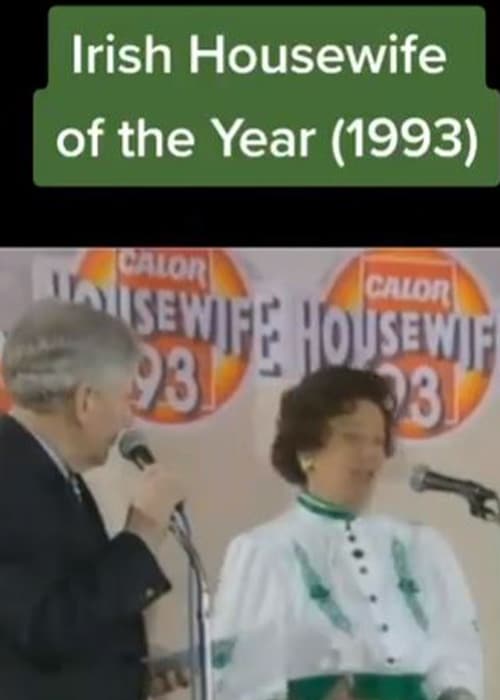Keith Garcia will present his 14th annual CinemaQ Film Festival this week. Overall, he programs about 600 films a year to screen at the Sie FilmCenter.
Sie FilmCenter Artistic Director Keith Garcia was well on his way to becoming what he self-identifies as “the pizza- and horror-loving queer Latinx film programmer of your dreamz” all the way back in the womb.
“My mom was always watching horror films when she was pregnant with me,” said Garcia – presumably with pizza. “And I just absorbed them.”
The Garcia family absorbed hundreds of films together from their living room to cinemas all over the south metro area. Villa Italia. Brentwood Plaza. Target Village 3. Double features at the Cinderella Twin Drive-In. Garcia’s earliest memory there was seeing the 1970s eco-horror film “Frogs,” with its poster of an adorable polliwog and a human hand trailing from its mouth – one quite possibly belonging to Ray Milland, Sam Elliott or Joan Van Ark.
While in pre-kindergarten, a young Garcia drew a picture of his whole family packed into its well-worn drive-in van. Behind them is the iconic Hollywood sign lit up with spotlights. “I obviously had aspirations for Hollywood at age 3,” Garcia says with a laugh.
Film programmer Keith Garcia aptly calls himself ‘The Constant Watcher.’
“I do feel very lucky,” he added, to be 45 and thriving along a career path that was set from his story’s opening credits. This week his pride and joy, the annual CinemaQ Festival, returns for a 14th year. But Garcia takes just as much care in choosing all 600 films that screen each year at the Sie FilmCenter. Every single one of which, he swears, he has seen.
“One of reasons Keith has become an essential icon in our film community is because he has impeccable film taste, and he serves his audience in smart and creative and funny ways year-round,” said former colleague Britta Erickson, a film producer for Denver’s Listen Productions.
‘The Return of the Living Dead.’
Take, for example, his “This Day in Cinema” program. Garcia loves to schedule movies for what he calls “the stupidest of reasons.” Like one day last month, when he slated a special screening of “The Return of the Living Dead.” “That movie takes place on July 3, 1984, at 5:30 p.m. Eastern Daylight Time,” he said. “So I scheduled the movie to start on July 3 at 3:30 p.m. Mountain Daylight Time.” (Because, you know – time zones.) Stupid? Sure. “But it sure was fun,” he said.
After graduating from Colorado Academy in 1995, Garcia set his untrained sights on becoming a filmmaker. But after trying a fancy college back east, he found more useful training in working his way up through Denver’s art houses. His hands-on prep started at age 19 behind the concessions counter at the Mayan Theatre. He has since worked his way up the ranks at Landmark Theatres, the Alamo Drafthouse and the Sie FilmCenter, where he first started working in 2004.
Westword once wrote, “If you like horror, science fiction or weird, (bleeped-up) cult films, chances are good you’re well-acquainted with Garcia’s work.” And yet, he doesn’t fit easily into the stereotype of the aesthete snob who looks down on mainstream or blockbuster films.
“I never look down,” Garcia said. “I am always looking around at all different types of film.”
Charles Busch, center, will be in Denver on Aug. 11 to talk about his new film ‘Sixth Reel’ at CinemaQ.
Garcia just loves movies. He not only remembers what films he’s seen but where he’s seen them. He still keeps 600 physical movies at his apartment and stores 500 classic posters under his bed. His prized piece of memorabilia – the one thing he says he’d grab if the building caught on fire – is a now evaporated cheap plastic “Fargo” snow globe that came with the VHS tape he bought at the Villa Italia video store in 1996. It depicts pregnant police chief Marge looking over a dead body next to an overturned car, with dried glitter stuck to snowflakes that have been painted blood red. “I keep it close to the front door, probably subconsciously so if I need to, I can grab it quickly,” he said.
To Garcia, your film sensibilities don’t have to be an us vs. them dealbreaker. “I like anything that spins the imagination,” he says.
Exhibit A: Yes, you will find ponderous dramas and buzzworthy foreign films at the Sie. But, right now, you also will see the Patton Oswald comedy “I Love My Dad,” about an estranged father who catfishes his son; and Brad Pitt’s assassins buddy pic “Bullet Train.”
“I don’t view that as pandering,” Garcia said. “I programmed ‘Bullet Train’ because it’s a fun film, and I want there to be a fun summer film right now at the FilmCenter. There is story enough out there for all kinds of people.”
Exhibit B: Garcia’s two favorite films are “Who Framed Roger Rabbit?” and “Women on the Verge of a Nervous Breakdown,” both of which he saw when they came out in 1988 – when he was 11.
“Roger Rabbit,” is, of course, Robert Zemeckis’ animated mystery about a cartoon-hating detective who is a rabbit’s only hope to prove his innocence when he is accused of murder.
When Garcia first saw the film, “You could not have told me that cartoons did not live in our world with us,” he said. And he’s not talking about some 5-year-old kid saying, “Cartoons are real!” He’s talking about an 11-year-old who fully accepted the world of the story as our own. “That movie just got to me,” he said. “Enough so that my friend and I ran to the bathroom and hid, and then snuck back in and watched it again.”
Then there was his introduction to the work of Pedro Almodóvar, the irreverent Spanish director who has left a major imprint on Garcia’s life. “Women on the Verge of a Nervous Breakdown” was Garcia’s first subtitled, cross-cultural movie. And it was from a director who was openly gay. It was a movie that, in its way, led to Garcia’s creation of the CinemaQ Festival in 2009.
Garcia feels “incredibly lucky” that he does not have a traumatic coming-out story of his own. “I pretty much coasted through high school feeling supported and never really saw the ugly side of coming out,” he said.
But he knew he was different, and film became a major part of navigating his adolescence. He had Almodóvar at age 11. John Waters in his mid-teen years. He even showed his mother a twin bill of Waters’ two tonal extremes: “Pink Flamingos” and “Hairspray.” (“She had no idea Divine was a drag queen,” he says with a laugh.)
But Garcia learned to code movies at a young age. In the 1970s, he said, “the major studios bankrolled a ton of gay cinema.” But what they were bankrolling were films like “Deliverance,” The Ritz,” “Dressed to Kill” and “Cruising.” None depicting particularly healthy gay lifestyles.
“There has always been a kind of a subtext in pop culture that queer people just pick up on,” Garcia said. “And for a long time, the message that was being sent to queer kids was that there was something wrong with them.”
That may be why the queer community has historically taken a liking to horror going all the way back to Mary Shelley’s ‘Frankenstein’.” A lot of queer people, Garcia said, identify with the monsters in horror films.
“James Whale was queer and he was dealing with a lot of that stuff in Hollywood and in his life when he made ‘Frankenstein’ in 1931,” Garcia said. “A lot of us can identify with this put-together monster who didn’t know any better and was just trying to lumber around while being chased by the villagers who wanted to destroy him.”
The AIDS crisis, Garcia said, made queer cinema a dirty word. Most famously when “A Nightmare on Elm Street 2: Freddy’s Revenge” became a nightmare for its closeted star, Mark Patton. “That movie was definitely written to vilify queer people,” Garcia said – and queer people noticed. Patton plays Jesse Walsh, a conflicted teen who won’t get close to his girlfriend because something keeps coming between them – and that something is Freddy Krueger (literally). The message, Garcia said, was clear: “You should repress the dark thing that is inside of you.”
With the rise of monkeypox, Garcia again sees the queer community “having a potential health crisis erroneously thrust upon us as if it was caused by us. But today we have more channels to speak against that, and to educate and to help change the direction of the conversation.”
And one of those channels is the in-person return of CinemaQ.
“After everything that has happened, being able to be in the theaters with our community and watch movies and talk about them together is very important this year,” said Garcia, who programs the festival according to his three core V’s: Queer vision, voices and visibility.
Keith Garcia with his beau, Charles Bloom, at the 2021 Denver Film Festival.
“First and foremost, this festival is for the queer audience,” he said. “We have had such a struggle identifying with queer individuals in most pop culture that we need a place like this where we can identify all over the place. But at the same time, CinemaQ is also the perfect place for allies to come – not to look at the animals like it’s a zoo, but rather to be like, ‘I would like to meet more people with more stories.’
“The rudimentary fact is that queer cinema is just human cinema.”
Garcia hopes next week when lines cue up at the Sie FilmCenter that he meets young gay kids or trans kids or kids of color standing in line feeling welcome and not scared.
“That is incredibly important to me,” he said. “I ultimately want the Sie FilmCenter to be a home for everybody to feel safe exploring all of their queries and hopes and dreams and desires and fears through cinema.
“But specifically, as a queer person, I want this to be a safe space for other queer people to have that 100 percent authentic experience of feeling part of a community and not left alone in the dark. That is paramount to me.”
Keith Garcia as drag persona Jerrika Benton.
BONUS: A life in drag
If you ask Keith Garcia what else occupies his life other than film, he really has to stop and think about his answer. But over the years, he has also become something of a hero in the local drag community.
For 13 years, Garcia has been chronicling their stories in interviews and performances for what will one day be a documentary called “The Heels Have Eyes.” His own drag persona is Jerrika Benton, which comes from the 1980s Saturday morning cartoon “Jem and the Holograms, about a record-company owner and her singing singer alter ego.













